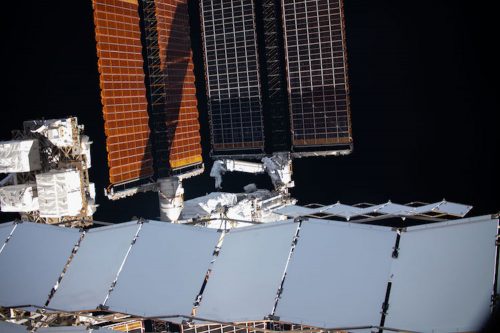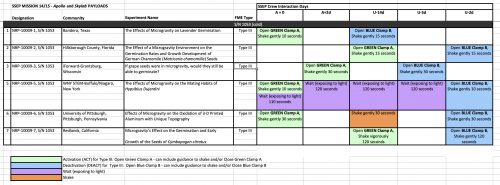An Update on SSEP Spaceflight Operations – This is the Real Space Program

NASA astronaut Shane Kimbrough (left) and ESA (European Space Agency) astronaut Thomas Pesquet maneuver the first ISS Roll-Out Solar Array (iROSA) into place on the space station’s port 6 truss structure during a spacewalk June 16, 2021.
SSEP Apollo and Skylab experiment payload crew interactions were conducted by NASA Astronaut and ISS Flight Engineer, Megan McArthur on schedule Thursday, September 16, 2021. McArthur interacted with 5 of 6 SSEP experiments. These interactions were pre-planned activities defined by the student flight teams for fourteen days prior to undocking (designated U-14).
Flight Engineer McArthur interacted with the experiments at 8:25 am EDT. Details of the interactions on orbit were then communicated to Earth, to Marshall Space Flight Center, and then in turn to Johnson Space Center and to our launch services provider, Nanoracks. Nanoracks then informed the National Center for Earth and Space Science Education at 9:23 am EDT. The Center then formally recorded the activity on the SSEP Mission 14/15 to ISS Experiment Log page.
This communications pathway is critical for experiment success. The student flight teams are using the information provided on the Log page to carry out concurrent ground truth experiments. Conducting identical experiments on the ground is critical. Once the flight experiment (operating in the apparent absence of gravity) is returned to Earth, an analytical comparison with the ground experiment (operating in the presence of gravity) allows the role of gravity to be assessed for the physical, chemical, or biological system under study.
This is the third of five scheduled Crew Interaction Days with the Apollo and Skylab experiments: Arrival day (A=0); Arrival plus 2 days (A+2); Undock minus 14 days (U-14); Undock minus 5 days (U-5); and Undock minus 2 days (U-2). The schedule of available Crew Interaction Days for SSEP is one of many real spaceflight operational constraints that all student teams must take into account when designing and proposing SSEP experiments. Click on the graphic at right to see the Crew Interaction Schedule for Apollo and Skylab experiments, which were integrated into the overall ISS crew schedule by Marshall Space Flight Center and Nanoracks months before launch as part of lock-down of the flight configuration for all SSEP experiments.
To provide a sense of the formal communications for Apollo and Skylab experiment activity, below is the first NanoRacks communique received by the National Center for Earth and Space Science Education providing the details of the on-orbit activities:
NanoRacks Communique
ISS U-14d interaction as follows:
NanoRacks Module 9
ISS Crew Member Megan McArthur performed the following Nanoracks Mixture Tube interactions on-orbit on Thursday, September 16, 2021. The interaction began approximately at 12:25 GMT. The crew reported that all ops were nominal.
The following clamps were opened:
S/N 1053
Tube Community
1 Bandera, TX (blue)
2 Hillsborough, FL (green)
5 Buffalo, NY (no clamp opened)
6 U. Pitt, (no clamp opened)
7 Redlands, CA (green)
The following experiments were shaken:
S/N 1053
Tube Community
1 Bandera, TX (gently, 15 seconds)
2 Hillsborough, FL (gently, 15 seconds)
5 Buffalo, NY (exposing to light, 120 seconds)
6 U. Pitt, (gently, 30 seconds)
7 Redlands, CA (vigorously, 120 seconds)
Unexpected Events: n/a
Topics for resolution: n/a
The Student Spaceflight Experiments Program (SSEP) is a program of the National Center for Earth and Space Science Education (NCESSE) in the U.S., and the Arthur C. Clarke Institute for Space Education internationally. It is enabled through a strategic partnership with NanoRacks LLC, working with NASA under a Space Act Agreement as part of the utilization of the International Space Station as a National Laboratory. SSEP is the first pre-college STEM education program that is both a U.S. national initiative and implemented as an on-orbit commercial space venture.
The Smithsonian National Air and Space Museum, Center for the Advancement of Science in Space (CASIS), and Subaru of America, Inc., are National Partners on the Student Spaceflight Experiments Program.


Comments are closed.